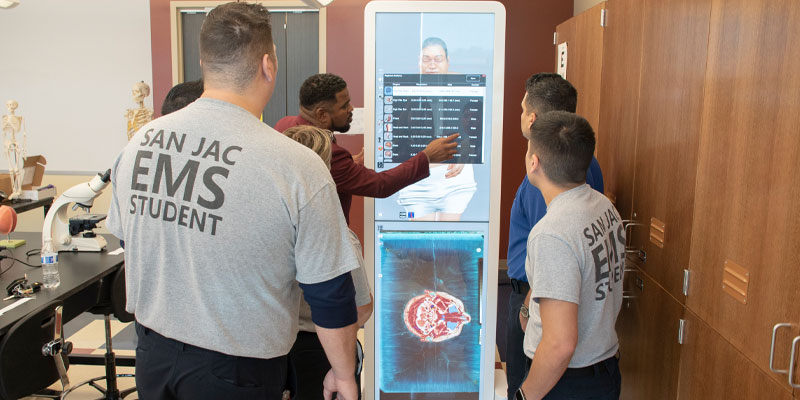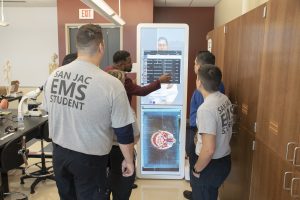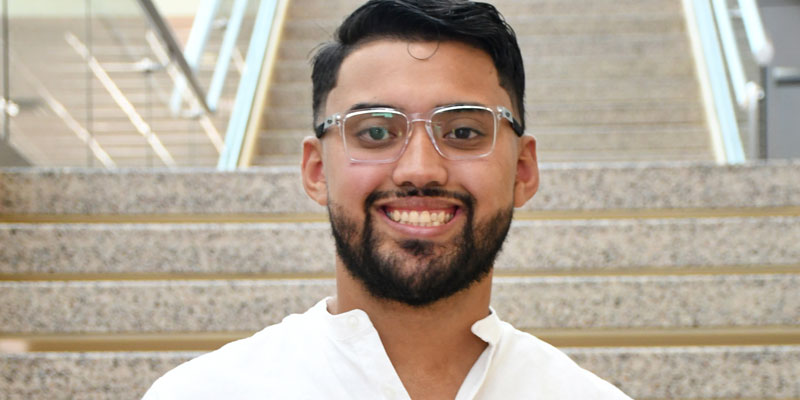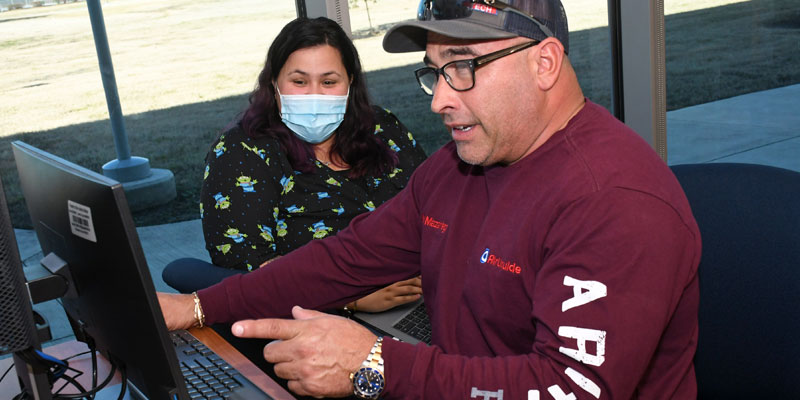
By Neesha Hosein
Cadavers are not something commonly seen in community college science labs, but San Jacinto College has secured the next best thing for learning anatomy.
Five Anatomage digital cadaver dissection tables now call San Jac home with two at Central Campus and one each at the North, South, and Generation Park Campuses.
What is Anatomage?
The Anatomage tabletop, an interactive touch screen, comes loaded with four life-sized 3D cadavers based on real male and female cadavers imaged in 1-millimeter slices from head to toe. The table displays words and information that correspond with what the user is touching on the screen.

Anatomage table
“The tables have high-resolution pictures of these cadavers,” said Dr. Teddy Farias, North Campus dean of health and natural sciences. “We can’t replace working with a real cadaver, but this is very close and a lot more cost-effective. It’s like a giant iPad.”
Compared to the vivid pictures in textbooks like Netter’s or Grey’s Anatomy, Farias believes the Anatomage table is an upgrade over a digital textbook.
Farias led the districtwide purchase of the five Anatomage tables last July, which were purchased with Higher Education Emergency Relief Funds.
Bells and whistles
Besides four human bodies, the Anatomage table also displays animals for digital dissection and other images useful for science and health science students to study.
“The company synthesized other specimens that are not based on a real cadaver but were created based on our knowledge of anatomy,” Farias said. “One example shows what a baby looks like in utero. There are several other scenarios, like a gunshot wound to the head, an inflamed lung, heart disease, MRIs, CT scans, and thousands of other case studies.”
The table comes equipped with a multitude of learning applications and is compatible with online classes. It can accommodate virtual tests and quizzes. Digital capabilities also allow it to be used via Zoom or to project images onto a screen for a class to view. Each campus has a designated lab for the tables, but since they have wheels, they can be moved to other labs or classrooms. The table can also be positioned vertically, which makes it easier to display to a face-to-face class.
Training sessions were held during College Community Week, but implementation is still in the early stages.
“Faculty are just getting introduced to the tables, so it’s too soon to fully incorporate it into their curriculum,” Farias said. “Some faculty might be able to use it in place of a YouTube video or pictures to discuss specific subjects.”
Who will use the tables?
The Anatomage table will be used to teach anatomy and physiology but will also be a valuable learning tool in many courses. Farias believes this is a great opportunity for interdisciplinary use and will be beneficial to more than one program.
Farias described the table as a multi-functional tool that several of the health science programs could use, including nursing, respiratory therapy, surgical technology, paramedic, medical assisting, occupational therapy assistant, and physical therapist assistant. The material included in the table’s database is relevant for many programs and will serve as a visual tool for hands-on learning, remediation, and tutoring sessions.
The Anatomage tables were officially integrated into course curriculums starting in spring 2023.
“The biology department is brimming with excitement as we introduce classroom material created using the Anatomage table into our lessons,” said Lambrini Nicopoulos, South Campus life sciences department chair. “More importantly, we are looking forward to having every student engage directly with the table to visualize the different systems in the body, perform virtual dissections, and participate in content-specific case studies.”




